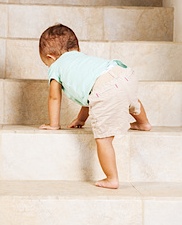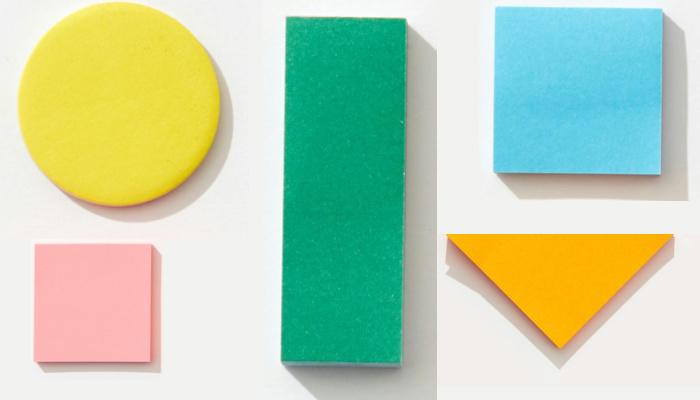Crawling & Climbing for Blind Babies

Crawling and climbing are two very important physical developmental milestones for babies and children who are blind. Some babies may skip these steps or reach them later than their typically developing peers, but there are many ways you can encourage crawling and climbing.
The Benefits of Crawling
While it is common for children who are blind to bypass crawling it is also common for them to achieve this milestone with a period of intensive intervention, and it is considered important for several reasons. A significant period of crawling is thought to have extra benefits for children with severe visual impairments because it:
- Increases upper body strength and shoulder girdle stability for critical VI and O&M skills later (e.g., operating Braillers, keyboards, and other equipment, using various types of doors independently, and using mobility devices and long canes effectively).
- Provides exposure to everyday textures and surfaces, thereby increasing tactile tolerance and discrimination.
- Provides weight bearing across the palms for improved grasp and manipulation of objects. This is important for pre-Braille, Braille, and other early literacy skills, as well.
Also, experience crawling up and down steps and single depth changes (e.g., curbs, landscape timbers, etc.) provides hands-on tactile, kinesthetic, and spatial experiences with vertical space, resulting in greater understanding and confidence when asked to walk up and down the same. In addition, teaching crawling up and down simple steps (with close supervision) often provides the child with the safest method of negotiating them independently.
Why I Love to Crawl & Climb! (as explained by Gus)
Hey! I’m Gus and I am 17 months old. I’m here to tell you about my new discovery… stairs! You should see me zip up and down. Mom stays right beside me and makes sure I do it safely. At first, I didn’t have a clue about what they were like, since I can see only a little bit of sunshine, but she showed them to me every day. I sat on the wood floor at the bottom of the stairs, while she sat on the first step beside me. We played a game of crawling in and out of her lap. A couple of days later she was placing my favorite Elmo toy on the step, and I went right after it since I was beginning to feel brave. Pretty soon I figured out how to climb up two steps on my hands and feet. Wowee! This was fun – a whole new world to explore!

I heard Mom say, “Yikes!” and I knew she was planning to watch me very carefully now that I had it figured out. When I try to stand up on the stairs she reminds me to go back to my hands and feet (or hands and knees.) Such a clever gal! She also showed me how to go down the steps feet first on my tummy. I tell you, she gets smarter every day! She even knows to block the stairs with her body when we’re playing “climb the mountain” so I can only go up and down the first 2 or 3 steps. Best of all, she or Dad always puts up that baby gate to keep me off the stairs altogether when they cannot be right with me.
Dad and I do other climbing games during our “tumble time” before dinner. We wrestle and roll all over the floor, and I climb on and off of him. Sometimes he helps me climb up on the couch for a tickle game, or climb down (feet first-tummy down) to stand and “hop on pop!” It’s really fun to climb over a lumpy obstacle course of couch cushions and Dad. Mom helps with this part.
I can’t wait ’til spring time when Dad says we’ll explore the front steps. And, guess what! I heard him and Mom talking about putting a little climber in the back yard this summer. Well, wait a sec! I guess now I’m a little climber, too!
The Benefits of Climbing
- Increases tactile tolerance and discrimination skills.
- Increases upper body strength.
- Provides spatial concepts of steps and stairs through hands-on exploration.
- Increases understanding and confidence in preparation for negotiating steps in walking.
- Provides the safest method of independent (supervised) negotiation of steps and stairs, prior to the onset of stable walking up and down the same.
Read this article in Arabic: قراءة هذا المقال بالعربية
Read this article in Dutch: Kruipen en Klimmen

Related Posts

Visual Impairment
The Gift of Understanding: How a Young Child Helps His Blind Father Navigate Life
When a parent is blind, it’s natural for people to wonder how their sighted child will adapt. Will they struggle to understand their parent’s needs? Will they feel burdened by...

Braille and Literacy, Toys, Visual Impairment
24 Braille Toys for Kids Who are Blind
Everything from alphabet blocks to raised line coloring pages and activity books to puzzles to card and board games... and so much more! And it's all in braille ready for...

Tactile Arts and Crafts, Visual Impairment
Using Origami to Teach Blind and Low-Vision Students Basic Shapes
If, like me, you have wondered why it is important for young students to learn about shapes, here are just a few reasons. Teaching shapes in early education provides children...